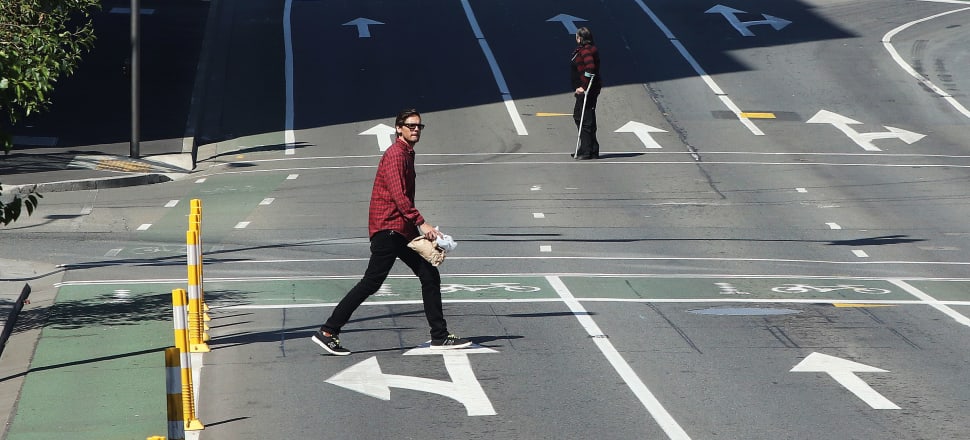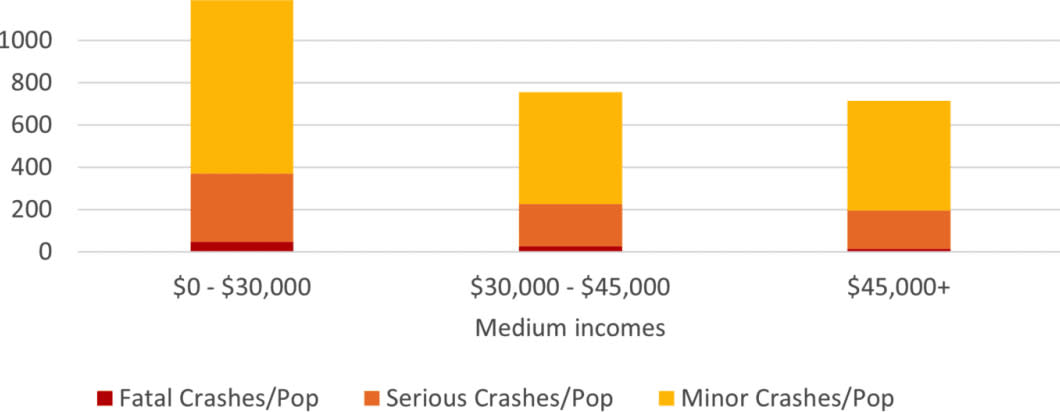
People walking in areas where the median income is less than $45,000 are more likely to be hurt or killed by a vehicle than if they were walking around in a more affluent area
New data shows pedestrians are more likely to be injured or killed in lower socio-economic areas.
The numbers come from transport planning and engineering company Abley who relied on census data from 2018 and crash statistics. READ MORE: * Public pump brakes on lower speed limits * The government we elect will shape the councils that decide our rates and roads
Principal Transportation Engineer Lewis Martin said similar to other countries around the world pedestrian deaths and injuries were more likely in areas of higher deprivation.
“It's fair to say that our communities that are already suffering economically, are obviously not receiving equitable road safety investment.
Pedestrian crashes per million population (2018-22)

Martin said there were a number of reasons behind this trend.
He said affluent residential areas generally had higher quality infrastructure features, such as better footpaths, more speed calming treatments, safe pedestrian crossings and the like.
"This again is due to multiple reasons. Developers have to follow stricter rules when it comes to building new developments than local governments do when it comes to retrofitting existing environments.
"To add to this once these environments are built and require maintenance local governments generally replace like for like. This means that 'better' environments get 'better' infrastructure and 'poorer' environments get 'poorer' infrastructure."
Car ownership was also a factor with people in lower-income areas likely to drive old vehicles without pedestrian safety technologies.
"There are also normally higher levels of car ownership in higher income communities. This results in less walking and thus less exposure for pedestrians. But shouldn't this also mean they get more pedestrian investment since more people are walking."
He said it was also common for more affluent areas to have a "louder voice" when it came to lobbying local councils for safer streets.
"For people with louder voices I believe they do it from a genuinely good place, they want to improve their communities, but what I think that can often do is push funding away from poorer communities.
"For example, if there's an affluent community and they see a road safety problem, say one of their crossings is a zebra and they feel like it needs to be improved, they might push and push and push and finally get the local council to put in a signal crossing. They'll feel like it's a massive achievement, but the funding for that doesn't come from nowhere."
He said making decisions that were data-driven were critical in avoiding this potential bias, however this data could be hard to come by.
"For the whole network for vehicles, for example, we have predictions or estimations of average annual daily traffic, we don't have that for pedestrians in a lot of cases. So we don't know how many people are walking in these areas and we're not actively creating prediction models at a network level to understand that better.
"Because of this it's incredibly difficult to work out between a few locations where you're going to put in these safety treatments... So I think that's the kind of change that we need, we need to move to a network-wide analysis. It won't be a perfect estimation, but we use the data sources we have, we look at gaps and we build this model and we can tell where we should at least start off rather than being driven by loud voices."
He said the issue was generally not well understood across councils.
"It's also just quite difficult to do and if you're a small council, out in the wops, you're not going to necessarily understand all of these things. You won't have access to all the data sources. You understand your community really well but you'll also be, I think, driven by the louder voices."
Northland Transportation Alliance Maintenance and Operations manager Bernard Petersen said the socio-economic status of an area was not a factor in its road safety investment programme.
"An important part of developing road safety improvements involves tracking crash statistics. This includes investigating the crash history of an area and types of crashes that occur there. It does not include the socio-economic status of the area.
"In the Far North, the Northland Transportation Alliance develops safety programmes on behalf of Far North District Council, using a number of factors including crash statistics, severity and type. All safety improvement projects are evidence based. The socio-economic status of an area or whether a community is seen to have a ‘loud voice’ is not part of these considerations."
However he said the level of funding support from government, through Waka Kotahi for transport investment was based on social deprivation.
"Waka Kotahi develops the Communities At Risk Register, which among many factors considers social deprivation, social cost from road trauma and risk to a community. This register helps determine what level of funding support (Financial Assistance Rate) each council receives. Far North District Council receives one of the highest Financial Assistance Rates in the country."
Auckland Transport delved into this issue last year finding that walking made up 1.2 percent of the total distance travelled by people in Auckland, but up to 36 percent of road deaths and serious injuries, when you included things like slips, trips and falls.
Transport Safety Technical lead Ping Sim agreed that good data was critical to understanding where to invest in road safety systems.
"Our residential speed management program which put in a lot of safe walking infrastructure, [such as] raised pedestrian crossings... Manurewa in the south of Auckland was chosen for the first two locations there. There were high customer requests, but we also used the data.
"So it was a high crash risk, then we looked at walking and cycling safety data which was also scored a high and then we looked at number of schools and the local nature of the area and so Manurewa actually scored a high across all those metrics and so they actually got their investment first and the evaluation from that has been really outstanding."
She said feedback from local boards was another way to evaluate where the need might be.
"They've really got their ear to the ground with the communities and they know what their communities need and they express that."
In Christchurch, Transport Operations Manager Stephen Wright denied "louder voices" influenced where investment went.
"We take all the feedback received through many communications channels to council to help inform our capital programme. Change must occur where there is the greatest need, which is generally based on risk to all users."
He said the city had a number of initiatives underway to make roads safer including lowering speed limits around schools and neighbourhoods, Trialling road layout changes via the Government's Streets for People programme and that council had recently given the green light to a large amount of safety improvements throughout Linwood and Bromley through the Government’s Transport Choices programme.







